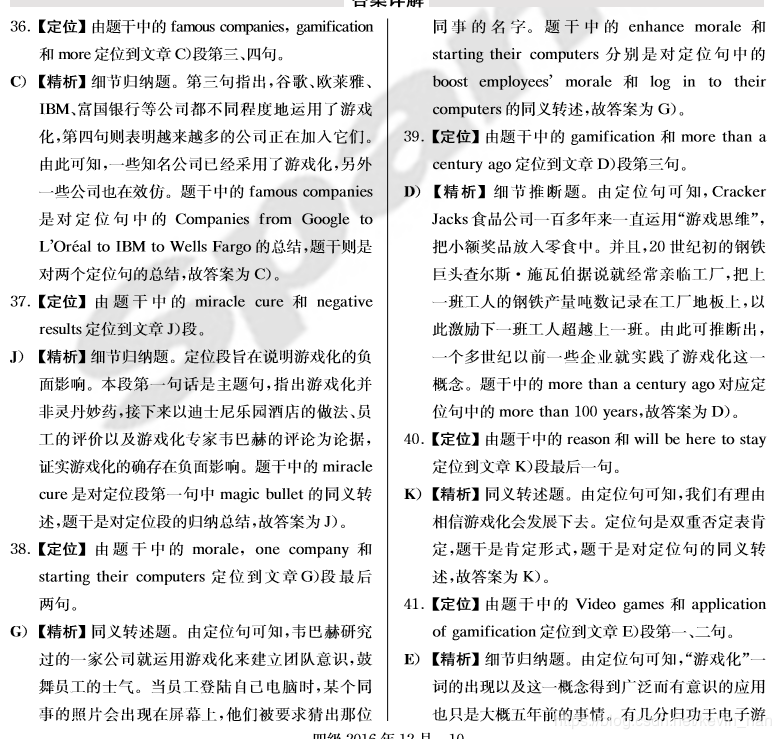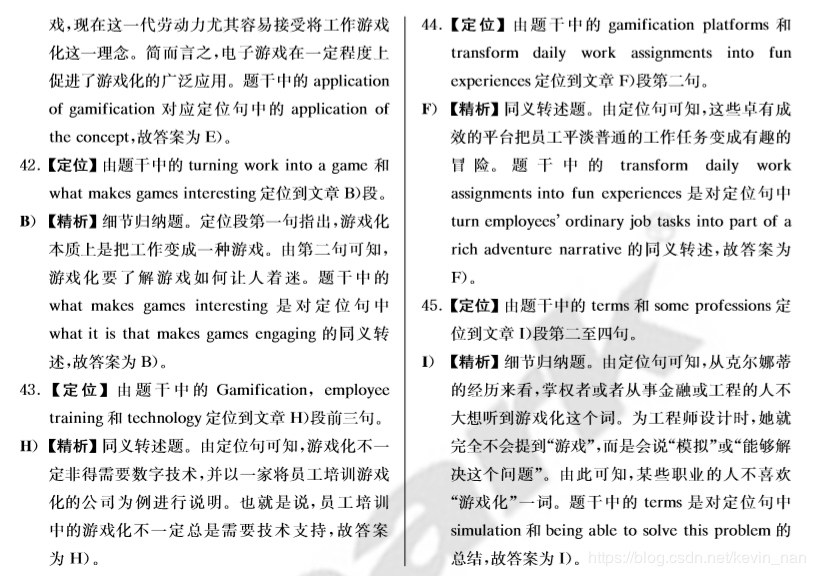When Work Becomes a Game
When Work Becomes a Game
A) What motivates employees to do their jobs well? Competition with coworkers, for some. The promise of rewards, for others. Pure enjoyment of problem-solving, for a lucky few.
motivate 激发 competition竞争 promise答应、诺言 pure纯的

B) Increasingly, companies are tapping into these desires directly through what has come to be known as "gamification" : essentially, turning work into a game. "Gamification is about understanding what it is that makes games engaging and what game designers do to create a great experience in games, and taking those learnings and applying them to other contexts such as the workplace and education," explains Kevin Werbach, a gamification expert who teaches at the Wharton School of Business at the University of Pennsylvania in the United States.
tap敲、利用
desire愿望、渴望的事物
gamification(game)游戏化
essentially本质上
engage吸引
designer设计者
expert 专家 熟练

C) It might mean monitoring employee productivity on a digital leaderboard and offering prizes to the winner, or giving employees digital badges or stars for completing certain activities. It could also mean training employees how to do their jobs through video game platforms. Companies from Google to L'Oréalto IBM to Wells Fargo are known to use some degree of gamification in their workplaces. And more and more companies are joining them. A recent report suggests that the global gamification market will grow from $1.65 billion in 2015 to $11.1 billion by 2020.
monitor班长 监视
productivity生产效率
digital 数字
leaderboard积分排行榜
badge 徽章
certain确定
train训火车、训练
platform平台
talent天赋
brain大脑

D) The concept of gamification is not entirely new, Werbach says. Companies, marketers and teachers have long looked for fun ways to engage people's reward-seeking or competitive spirits. Cracker Jacks has been "gamifying" its snack food by putting a small prize inside for more than 100 years, he adds, and the turn-of-the-century steel magnate (巨头) Charles Schwab is said to have often come into his factory and written the number of tons of steel produced on the past shift on the factory floor, thus motivating the next shift of workers to beat the previous one.
concept概念
entirely全部地
seek寻找
spirit精神
factory工厂
shift换班工作
previous以前的
steel钢

E) But the word "gamification" and the widespread, conscious application of the concept only began in earnest about five years ago, Werbach says. Thanks in part to video games, the generation now entering the workforce is especially open to the idea of having their work gamified. "We are at a point where in much of the developed world the vast majority of young people grew up playing video games, and an increasingly high percentage of adults play these video games too," Werbach says.
conscious意识到
earn 赚取
especially特别的
vast巨大的、辽阔的
percentage 百分率

F) A number of companies have sprung up—Gam Effective, Bunchbail and Badgeville, to name a few--in recent years offering gamification platforms for businesses. The platforms that are most effective turn employees' ordinary job tasks into part of a rich adventure narrative. "What makes a game game-like is that the player actually cares about the outcome," Werbach says. "The principle is about understanding what is motivating to this group of players, which requires some understanding of psychology. "
sprung up网络兴起
narrative叙述
negative消极的
principle道德原则
psychology心理学

G) Some people, Werbach says, are motivated by competition. Sales people often fall into this category. For them, the right kind of gamification might be turning their sales pitches into a competition with other team members, complete with a digital leaderboard showing who is winning at all times. Others are more motivated by collaboration and social experiences. One company Werbach has studied uses gamification to create a sense of community and boost employees' morale(士气). When employees log in to their computers, they're shown a picture of one of their coworkers and asked to guess that person's name.
category种类
pitch投球 力度、场地
collaboration合作
boost鼓舞
log登陆

H) Gamification does not have to be digital. Monica Cornetti runs a company that gamifies employee trainings. Sometimes this involves technology, but often it does not. She recently designed a gamification strategy for a sales training company with a storm-chasing theme. Employees formed "storm chaser teams" and competed in storm-themed educational exercises to earn various rewards. "Rewards do not have to be stuff," Cornetti says. "Rewards can be flexible working hours. " Another training, this one for pay roll law, used a Snow White and the Seven Dwarfs theme. "Snow White" is available for everyone to use, but the "dwarfs" are still under copyright, so Cornetti invented sound-alike characters (Grumpy Gus, Dopey Dan) to illustrate specific pay roll law principles.
strategy策略
storm-chasing风暴追逐
stuff物资
flexible灵活的
roll卷(书) 滚动
theme主题演讲
form表格 类型
various各种各样的
available可获得的
illustrate解释说明
principle原则

I) Some people do not take naturally to gamified work environments, Cornetti says. In her experience, people in positions of power or people in finance or engineering do not tend to like the sound of the word. "If we are designing for engineers, I'm not talking about a 'game' at all, "Cornetti says. "I'm talking about a ' simulation' (模拟), I'm talking about ' being able to solve this problem. '"
engineer 工程师;设计师
tend 趋向

J) Gamification is " not a magic bullet," Werbach warns. A gamification strategy that is not sufficiently thought through or well-tailored to its players may engage people for a little while, but it will not motivate people in the long term. It can also be exploitative, especially when used with vulnerable populations. For workers, especially low-paid workers, who desperately need their jobs yet know they can be easily replaced, gamification may feel more like the Hunger Games. Werbach gives the example of several Disneyland hotels in Anaheim, California, which used large digital leaderboards to display how efficiently laundry workers were working compared to one another. Some employees found the board motivating. To others, it was the opposite of fun. Some began to stop taking bathroom breaks, worried that if their productivity fell they would be fired. Pregnant employees struggled to keep up. In a Los Angeles Times article, one employee referred to the board as a "digital whip. ""It actually had a very negative effect on morale and performance," Werbach says.
bullet弹丸
sufficient足够的;
engage吸引
exploit 压榨
vulnerable脆弱的
desperate绝望地
laundry洗衣服
opposite对立的
struggle奋斗 为...做斗争
morale士气
term期限

K) Still, gamification only stands to become more popular, he says, "as more and more people come into the workforce who are familiar with the structures and expressions of digital games. ""We are far from reaching the peak," Cornetti agrees. "There is no reason this will go away. "
peak顶峰 workforce全体员工
- Some famous companies are already using gamification and more are trying to do the same.C
- Gamification is not a miracle cure for all workplaces as it may have negative results.J
- To enhance morale, one company asks its employees to identify their fellow workers when starting their computers.G
- The idea of gamification was practiced by some businesses more than a century ago.D
- There is reason to believe that gamification will be here to stay.K
- Video games contributed in some ways to the wide application of gamification.E
- When turning work into a game, it is necessary to understand what makes games interesting.B
- Gamification in employee training does not always need technology.H
- The most successful gamification platforms transform daily work assignments into fun experiences.F
- It is necessary to use terms other than "gamification" for some professions.I





